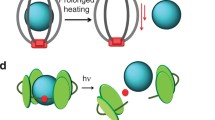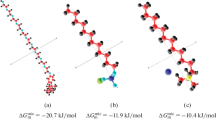Abstract
A water-soluble polyhydroxylated fullerene, i.e. a fullerenol, with 44 hydroxyl groups and 8 secondary bound water molecules, C60(OH)44·8H2O (estimated average structure), has been synthesized in a facile one step reaction from pristine C60 by hydroxylation with hydrogen peroxide in the presence of a phase-transfer catalyst, tetra-n-butylammonium hydroxide (TBAH), under organic/aqueous bilayer conditions. The fullerenol exhibited high water solubility, up to 64.9 mg/mL, under neutral (pH = 7) conditions. Dynamic light-scattering (DLS) analysis showed a narrow particle size distribution, of 1–2 nm, indicating that the fullerenol had high dispersion properties in water. The results of particle size analyses, which both focused on a single nanoregion and were conducted using a novel induced grating (IG) method and a scanning probe microscope (SPM), were consistent with the DLS results. A plausible reaction mechanism, which includes fullerene oxide intermediates detected by liquid chromatography-mass spectrometry (LC-MS), has been proposed.

Similar content being viewed by others
References
Jiao, F.; Liu, Y.; Qu, Y.; Li, W.; Zhou, G.; Ge, C.; Li, Y.; Sun, B.; Chen, C. Studies on anti-tumor and antimetastatic activities of fullerenol in a mouse breast cancer model. Carbon 2010, 48, 2231–2243.
Xu, J. -Y.; Su, Y. -Y.; Cheng, J. -S.; Li, S. -X.; Liu, R.; Li, W. -X.; Xu, G. -T.; Li, Q. -N. Protective effects of fullerenol on carbon tetrachloride-induced acute hepatotoxicity and nephrotoxicity in rats. Carbon 2010, 48, 1388–1396.
Mikawa, M.; Kato, H.; Okumura, M.; Narazaki, M.; Kanazawa, Y.; Miwa, N.; Shinohara, H. Paramagnetic water-soluble metallofullerenes having the highest relaxivity for MRI contrast agents. Bioconjugate Chem. 2001, 12, 510–514.
Chen, C.; Xing, G.; Wang, J.; Zhao, Y.; Li, B.; Tang, J.; Jia, G.; Wang, T.; Sun, J.; Xing, L.; Yuan, H.; Gao, Y.; Meng, H.; Chen, Z.; Zhao, F.; Chai, Z.; Fang, X. Multihydroxylated [Gd@C82(OH)22]n nanoparticles: Antineoplastic activity of high efficiency and low toxicity. Nano Lett. 2005, 5, 2050–2057.
Aoshima, H.; Kokubo, K.; Shirakawa, S.; Ito, M.; Yamana, S.; Oshima, T. Antimicrobial activity of fullerenes and their hydroxylated derivatives. Biocontrol Sci. 2009, 14, 69–72.
Chiang, L. Y.; Lu, F. -J.; Lin, J. -T. Free radical scavenging activity of water-soluble fulerenols. J. Chem. Soc., Chem. Commun. 1995, 1283–1284.
Dugan, L. L.; Gabrielsen, J. K.; Yu, S. P.; Lin, T. -S.; Choi, D. W. Buckminsterfullerenol free radical scavengers reduce excitotoxic and apoptotic death of cultured cortical neurons. Nerobiol. Dis. 1996, 3, 129–135.
Sun, D.; Zhu, Y.; Liu, Z.; Liu, G.; Guo, X.; Zhan, R.; Liu, S. Active oxygen radical scavenging ability of water-soluble fullerenols. Chin. Sci. Bull. 1997, 42, 748–752.
Lai, H. -S.; Chen, W. -J.; Chiang, L. -Y. Free radical scavenging activity of fullerenol on the iischemia-reperfusion intestine in dogs. World J. Surg. 2000, 24, 450–454.
Guldi, D. M.; Asmus, K. -D. Activity of water-soluble fullerenes towards ·OH-radicals and molecular oxygen. Radiat. Phys. Chem. 1999, 56, 449–456.
Xiao, L.; Takada, H.; Maeda, K.; Haramoto, M.; Miwa, N. Antioxidant effects of water-soluble fullerene derivatives against ultraviolet ray or peroxylipid through their action of scavenging the reactive oxygen species in human skin keratinocytes. Biomed. Pharmacother. 2005, 59, 351–358.
Oberdörster, E. Manufactured nanomaterials (fullerenes, C60) induce oxidative stress in the brain of juvenile largemouth bass. Environ. Health Perspect. 2004, 112, 1058–1062.
Chiang, L. Y.; Wang, L. -Y.; Swirczewski, J. W.; Soled, S.; Cameron, S. Efficient synthesis of polyhydroxylated fullerene derivatives via hydrolysis of polycyclosulfated precursors. J. Org. Chem. 1994, 59, 3960–3968.
Li, J.; Takeuchi, A.; Ozawa, M.; Li, X.; Saigo, K.; Kitazawa, K. C60 Fullerol formation catalysed by quaternary ammonium hydroxides. J. Chem. Soc. Chem. Commun. 1993, 1784–1785.
Schneider, N. S.; Darwish, A. D.; Kroto, H. W.; Taylor R.; Walton, D. R. M. Formation of fullerenols via hydroboration of fullerene-C60. J. Chem. Soc., Chem. Commun. 1994, 463–464.
Arrais, A.; Diana, E. Highly water soluble C60 derivatives: A new synthesis. Fuller. Nanotub. Carbon Nanostruct. 2003, 11, 35–46.
Wang, S.; He, P.; Zhang, J. -M.; Jiang, H.; Zhu, S. -Z. Novel and efficient synthesis of water-soluble [60]fullerenol by solvent-free reaction. Synth. Commun. 2005, 35, 1803–1807.
Vileno, B.; Marcoux, P. R.; Lekka, M.; Sienkiewicz, A.; Fehér, T.; Forró, L. Spectroscopic and photophysical properties of a highly deivatized C60 fullerol. Adv. Funct. Mater. 2006, 16, 120–128.
Kokubo, K.; Matsubayashi, K.; Tategaki, H.; Takada, H.; Oshima, T. Facile synthesis of highly water-soluble fullerenes more than half-covered by hydroxyl groups. ACS Nano 2008, 2, 327–333.
Zhang, G.; Liu, Y.; Liang, D.; Gan, L.; Li, Y. Facile synthesis of isomerically pure fullerenols and formation of spherical aggregates from C60(OH)8. Angew. Chem. Int. Ed. 2010, 49, 5293–5295.
Husebo, L. O.; Sitharaman, B.; Furukawa, K.; Kato, T.; Wilson, L. J. Fullerenols revisited as stable radical anions. J. Am. Chem. Soc. 2004, 126, 12055–12064.
Takaya, Y.; Tachika, H.; Hayashi, T.; Kokubo, K.; Suzuki, K. Performance of water-soluble fullerenol as novel functional molecular abrasive grain for polishing nanosurfaces. CIRP Ann.-Manuf. Tech. 2009, 58, 495–498.
Saotome, T.; Kokubo, K.; Shirakawa, S.; Oshima, T.; Hahn, H. T. Polymer nanocomposites reinforced with C60 fullerene: Effect of hydroxylation. J. Compos. Mater., in press.
Saitoh, Y.; Xiao, L.; Mizuno, H.; Kato, S.; Aoshima, H.; Taira, H.; Kokubo, K.; Miwa, N. Novel polyhydroxylated fullerene suppresses intracellular oxidative stress together with repression of intracellular lipid accumulation during the differentiation of OP9 preadipocytes into adipocytes. Free Radic. Res. 2010, 44, 1072–1081.
Matsubayashi, K.; Kokubo, K.; Tategaki, H.; Kawahama, S.; Oshima, T. One-step synthesis of water-soluble fullerenols bearing nitrogen-containing substituents. Fuller. Nanotub. Carbon Nanostruct. 2009, 17, 440–456.
Xing, G.; Zhang, J.; Zhao, Y.; Tang, J.; Zhang, B.; Gao, X.; Yuan, H.; Qu, L.; Cao, W.; Chai, Z.; Ibrahim, K.; Su, R. Influences of structural properties on stability of fullerenols. J. Phys. Chem. B 2004, 108, 11473–11479.
She, Y. -M.; Tu, Y. -P.; Liu, S. -Y. C118 from fullerenols: Formation, structure and intermolecular nC2 transfer reactions in mass spectrometry. Rapid Commun. Mass Spectrom. 1996, 10, 676–678.
Chiang, L. Y.; Upasani, R. B.; Swirczewski, J. W.; Soled, S. Evidence of hemiketals incorporated in the structure of fullerols derived from aqueous acid chemistry. J. Am. Chem. Soc. 1993, 115, 5453–5457.
Troyanov, S. I.; Troshin, P. A.; Boltalina, O. V.; Ioffe, I. N.; Sidorov, L. N.; Kemnitz, E. Two isomers of C60F48: An indented fullerene. Angew. Chem. Int. Ed. 2010, 40, 2285–2287.
Tuinman, A. A.; Mukherjee, P.; Adcock, J. L.; Hettich, R. L.; Compton, R. N. Characterization and stability of highly fluorinated fullerenes. J. Phys. Chem. 1992, 96, 7584–7589.
Rivelino, R.; Malaspina, T.; Fileti, E. E. Structure, stability, depolarized light scattering, and vibrational spectra of fullerenols from all-electron density-functional-theory calculations. Phys. Rev. A 2009, 79, 013201.
Ros, D. T.; Prato, M. Medicinal chemistry with fullerenes and fullerene derivatives. Chem. Commun. 1999, 663–669.
Bolskar, R. D.; Benedetto, A. F.; Husebo, L. O.; Price, R. E.; Jackson, E. F.; Wallace, S.; Wilson, L. J.; Alford, J. M. First soluble M@C60 derivatives provide enhanced access to metallofullrenes and permit in vivo evaluation of Gd@C60[C(COOH)2]10 as a MRI contrast agent. J. Am. Chem. Soc. 2003, 125, 5471–5478.
Mohan, H.; Palit, D. K.; Mittal, J. P.; Chiang, L. Y.; Asmus, K. -D.; Guldi, D. M. Excited states and electron transfer reactions of C60(OH)18 in aqueous solution. J. Chem. Soc., Faraday Trans. 1998, 94, 359–363.
Wada, Y.; Totoki, S.; Watanabe, M.; Moriya, N.; Tsunazawa, Y.; Shimaoka, H. Nanoparticle size analysis with relaxation of induced grating by dielectrophoresis. Opt. Express 2006, 14, 5755–5764.
Everett, A. J.; Minkoff, G. J. The dissociation constants of some alkyl and acyl hydroperoxides. Trans. Faraday Soc. 1953, 49, 410–414.
Gao, X.; Ishimura, K.; Nagase, S.; Chen, Z. Dichlorocarbene addition to C60 from the trichloromethyl anion: Carbene mechanism or Bingel mechanism? J. Phys. Chem. A 2009, 113, 3673–3676.
Zhang, P.; Pan, H.; Liu, D.; Guo, Z. -X.; Zhang, F.; Zhu, D. Effective mechanochemical synthesis of [60]fullerols. Synth. Commun. 2003, 33, 2469–2474.
Li, T.; Li, X.; Huang, K.; Jiang, H.; Li, J. Synthesis and characterization of hydroxylated fullerene epoxide—An intermediate for forming fullerol. J. Cent. South. Univ. Technol. 1999, 6, 35–36.
Wang, F. F.; Li, N.; Tian, D.; Xia, G. F.; Xiao, N. Efficient synthesis of fullerenol in anion form for the preparation of electrodeposited films. ACS Nano 2010, 4, 5565–5572.
Tajima, Y.; Takeuchi, K. Discovery of C60O3 isomer having C 3v symmetry. J. Org. Chem. 2002, 67, 1696–1698.
Author information
Authors and Affiliations
Corresponding author
Electronic supplementary material
Rights and permissions
About this article
Cite this article
Kokubo, K., Shirakawa, S., Kobayashi, N. et al. Facile and scalable synthesis of a highly hydroxylated water-soluble fullerenol as a single nanoparticle. Nano Res. 4, 204–215 (2011). https://doi.org/10.1007/s12274-010-0071-z
Received:
Revised:
Accepted:
Published:
Issue Date:
DOI: https://doi.org/10.1007/s12274-010-0071-z




